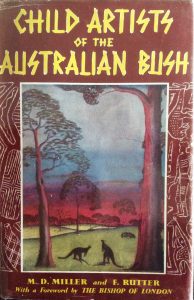Linda and I were in York this weekend with our great friends Graham and Cindy. When I am in a new town, I usually drop in to any bookshop I come across. In this case, it was Barclays Books, a shop well worth visiting if you are a book lover. I thought I’d see if I could find a copy of the book about the Carrolup child artists by Mary Durack Miller and Florence Rutter, Child Artists of the Australian Bush. In this regard, my visit was to no avail.
I have in possession my own copy of the book which I obtained a few years ago. Last year, I found a copy in a UK bookshop using Abe Books. I decided to give the copy to the Ryder family and presented it to them when they took John and I to the grave of their father Cliff Ryder and their young brother Christopher.
Here is an excerpt from our book Connection: Aboriginal Child Artists Captivate Europe about the above book:
“The book Child Artists of the Australian Bush, by Mary Durack Miller in association with Florence Rutter, is published in June 1952. It is a result of a fruitful collaboration and special friendship of two extraordinary women on opposite sides of the world.

Cover of the book Child Artists of the Australian Bush by Mary Durack Miller and Florence Rutter, published in 1952. The drawing on the cover is by Barry Loo.
The book shows the wonderful work of the Carrolup children and the Whites. It is published by George G. Harrap & Co. Ltd in the UK, and the closely linked Australasian Publishing Company in Australia. The drawing on the cover is by Barry Loo.
The main text comprises 64 pages, divided into 14 chapters. The book contains 36 reproductions of the children’s artworks, all but four (by Parnell Dempster, Ross Jones, Barry Loo and an unsigned artist) of which are in black and white, as well as seven black and white photographs of people from Mrs Rutter’s two visits.
In addition, the book contains Revel Cooper’s possum drawings (cf. Chapter 35), and three black and white photographs of pages of drawings and text from Revel’s schoolbook done during his last term at school in 1949.
The book starts with a Foreword by W M Londin, The Right Rev The Lord Bishop of London:
‘The Australian aboriginal is still regarded as the representative of the most primitive type of culture the world of our day can still reveal. It is only too often concluded that he is therefore of a very low type of intelligence. Nothing could be farther from the truth. Those who have had occasion to take advantage of his skill in woodcraft have long recognized in him a particularly quick and observant mind, and those who have had to unravel his very complicated table of kindred and affinity have recognized that, where the computing of human relationships is concerned, he has his European brother completely beaten.
It is only in recent years that we have begun to understand that, given a fair opportunity, he can acquit himself honourably in academic and artistic spheres. We have scarcely got accustomed to the brilliance of Namatjiri’s [Namatjira’s] water-colours when news comes of the amazing development of a most delicate artistic skill among a group of aboriginal children in Western Australia.
In this book the story is beautifully told. It will arouse in us a sense both of achievement and of failure. The failure is the white man’s, and it is none the less tragic because it is well-intentioned. One hopes that as a result of the publicity now given to the episode artistic skill will be given another chance and the social failure will be fully retrieved.’ CONNECTION: Aboriginal Child Artists Captivate Europe. David Clark, in association with John Stanton. Copyright © 2020 by David Clark

Print of Youth Chasing Kangaroo by Reynold Hart which appeared in Florence Rutter’s Little Black Fingers and in The Overseas and Transatlantic Mail. Mary Durack-Miller Collection, The J.S. Battye Library of West Australian History. The print also appeared in Child Artists of the Australian Bush.


